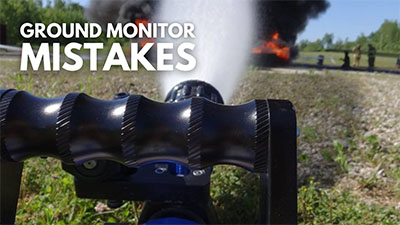5 Mistakes Firefighters Make with Ground Monitors
Ground monitor, initial attack monitor, portable monitor – whatever you call it, the ground monitor is a versatile piece of equipment that can help your crew on defensive and offensive fire ground attack.
Many firefighters use them outside of a structure for exposure protection, aim it through a doorway to hit the seat of a fire, or set them up in commercial building fires to hit it hard. But while doing any of these or the other tactics you can with a ground monitor, safety is paramount.
Are you making any of these mistakes while using yours?
Common Ground Monitor Mistakes:
Lifting the monitor while flowing:
Portable attack monitors are designed to flow while firmly placed on the ground or secured via another method. During flow, your portable monitor should not be moved. If you do need to move it or reposition it, the only safe way to do so is to close the valve or shut down flow first. This prevents you from experiencing large amounts of reaction and potentially being hit with an out-of-control monitor.
Not fully deploying the stabilization legs:
Portable monitors come with stabilizing legs that keep the monitor upright and in place. To help save storage space, these legs are often folded into the base and must be deployed prior to use. If you only deploy them part way, you risk the monitor losing balance and being unable to grip the ground properly. This puts you and your crew at risk.

Not securing or anchoring the monitor correctly:
NFPA1965, 2014 Edition 4.7.1 requires that all ground monitors have an anchor strap. This strap is used to further stabilize the monitor and limit the risk of injury from an out-of-control monitor and hose line. If your crew does not anchor the monitor correctly and the monitor shifts, it runs the risk of becoming a danger to you and your crew on the fire ground.
Purchasing a monitor without safety features:
While a flow limiting or shutdown safety mechanism might sound frustrating, they are a valuable part of any good ground monitor. These mechanisms limit flow or shut it down completely if your monitor experiences any sudden shifts or loses stabilization. This includes it lifting from the ground, rolling sideways, or pushing backward. A good ground monitor includes a safety mechanism and is easy to reset if it gets triggered. This not only protects you, but the rest of your crew and equipment.

Inadequate Training:
It’s easy to think all ground monitors are the same and that you can just pick up and go, but this isn’t true. Your crew should spend time training with each ground monitor you use to ensure familiarity with the safety features, valve, and nozzles. Failure to train well and regularly can lead to unsafe use and failure on the fire ground.
Conclusion:
Ground monitors are a valuable, useful, and versatile piece of firefighting equipment. Using it safely is just one piece of effective fire ground operations. In order to do so, be sure that you and your crew select a monitor with adequate safety features, train with it regularly, understand how to deploy and secure the monitor, and understand safe operation.
